- Video Production
- Video Making Tips for Beginners
- How to become a videographer
From Rookie to Pro: How to Become a Videographer That Matters
Want to know how to become a videographer and turn your passion for visual storytelling into reality?
Key Takeaways: How to Become a Videographer
- Storytelling is core: A videographer’s primary role is to craft narratives that resonate emotionally, not just record footage.
- Gear is a tool, not a goal: Start with basic equipment (smartphone, tripod, budget mic) and upgrade based on your niche and projects.
- Formal education vs. self-taught: Both paths work—combine workshops, online courses, and hands-on practice for balanced growth.
- Roles vary: Understand team dynamics (main shooter, second shooter, editor) or adapt as a solo creator handling multiple tasks.
- Avoid common pitfalls: Prioritize audience engagement over gear obsession, formulas, or superficial aesthetics.
- Build connections: Network locally, collaborate with creatives, and leverage social media to showcase authenticity, not just polish.
- Master fundamentals: Focus on lighting, sound, composition, and editing basics before chasing advanced techniques.
Imagine yourself behind a video camera, capturing moments of joy, sorrow, and everything in between.
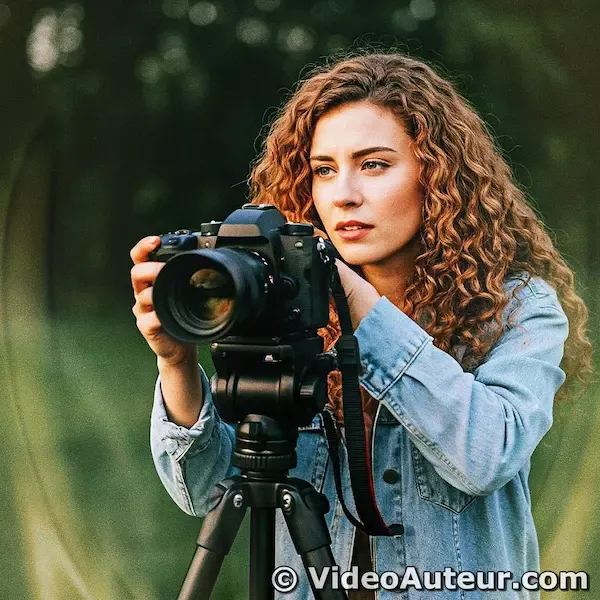 This article explains how to become a videographer or turn your interest in videography into a hobby or career.
This article explains how to become a videographer or turn your interest in videography into a hobby or career.As you review your footage, you're fascinated by the way moments of pure joy, laughter, even sadness, are forever preserved. And you think to yourself,...
"How amazing it is to create videos that can touch people's hearts!"
Sometimes, when shooting a really poignant moment, I find myself teary-eyed. I pull a handkerchief out of my pocket and wipe the teardrops that are about to fall. :-)
You may have limited resources and no formal education in videography. But you have passion and curiosity for visual expression.
And so, you're wondering how to become a videographer.
How can you turn your interest in videography into a hobby or career? Let's find out...
What is a videographer?
A videographer is a visual storyteller who captures moving images to create meaningful content that connects with audiences and evokes emotions.
They combine creative vision with technical camera skills, going beyond simply operating equipment.
Key points for beginners:
- More Than Just Tech: It's not just about having a camera and pressing record (like a "camera operator"). Technical skill is needed, but it's the starting point.
- Storytelling and Emotion: The core purpose is to tell stories and make viewers feel something through the visuals you capture.
- Meaningful Connection: Your goal is to create videos that resonate with people watching them.
In simple terms: Think of a videographer as a storyteller who uses a video camera as their pen.
Is a videographer really just a "person who shoots videos" simply because they have a camera?
If so, then anybody who has a smartphone and uses it to take pictures is already a photographer.
Think about it...
Someone who just wants to operate the camera is a "camera operator". It's similar to someone who operates the elevator and is called an "elevator operator".
In essence, the person involved is mainly dealing with the mechanical or technical stuff.
Is a videographer really just only involved with technical things?
According to Online Etymology Dictionary, the word "videographer" combines two elements, "video" and "-grapher".
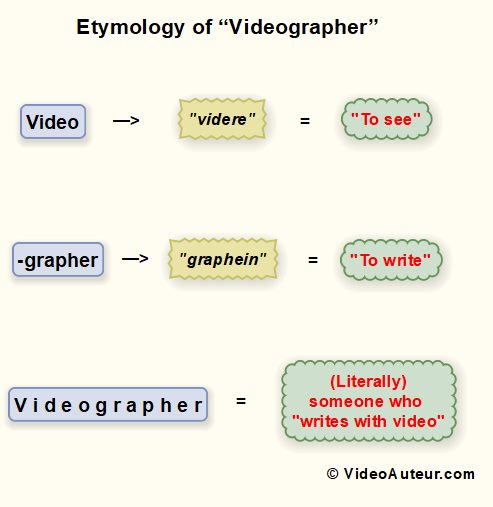 Where did the word "videographer" come from?
Where did the word "videographer" come from?"Video" comes from the Latin word, "videre", which means, "to see".
"-grapher" (or "-graph") is a suffix from the Greek word "graphein", which means, "to write".
So, a "videographer" is literally someone who "writes with video".
Or someone who creates visual content using video cameras but can manage both creative and technical tasks.
What this means is that...
A videographer is more than someone who points a camera and presses record.
A videographer transcends the mechanical act of recording, crafting visual narratives that resonate.
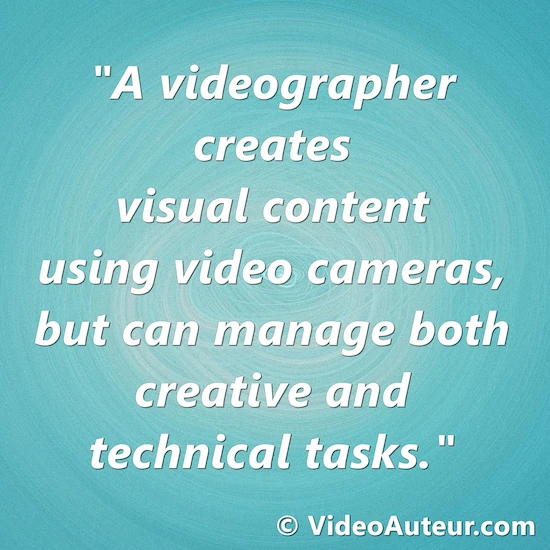 What is the real meaning of "videographer"?
What is the real meaning of "videographer"?A videographer is someone who...
- specializes in capturing moving images, and
- aims to evoke emotions and connect with audiences through their lens.
In short, a videographer is a visual storyteller who creates meaningful connections through their craft.
What do videographers do?
Videographers handle multiple tasks to create videos, typically for smaller-scale projects. Their core duties include:
- Planning: Scripting, shot planning, guides.
- Shooting: Operating cameras (camcorders, DSLRs, mirrorless), managing lighting and sound, interviewing, directing scenes.
- Editing: Turning raw footage into finished videos using editing software.
- Client Work (for paid projects): Collaborating to bring a creative vision to life.
Why so many roles? Because videographers often work independently or in small teams, requiring them to wear many hats.
Key takeaway for beginners: Focus on mastering these core skills (planning, shooting, editing, communication) rather than getting lost in technical gear obsession.
The goal is to create authentic videos that connect with viewers.
Videographers take on different roles. Some of the tasks that they do include...
- planning shots,
- operating cameras, and
- editing footage.
But they can also...
- write scripts,
- interview people,
- direct some scenes,
- manage lighting and sound, and
- work with clients to bring a creative vision to life (for paid video projects).
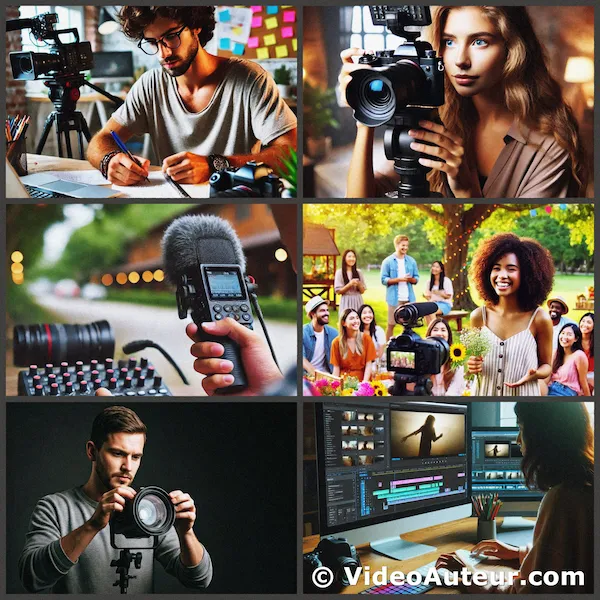 To learn how to become a videographer, one must understand what a videographer does.
To learn how to become a videographer, one must understand what a videographer does.If you're wondering why they juggle multiple roles, it's because many videographers find themselves working independently, or in small teams.
Unlike cinematographers who often work on larger productions, videographers usually handle smaller-scale projects.
--
Personally, I first learned writing scripts and guides for video shoots. Then, I learned to use various cameras like big and small camcorders, DSLRs, and mirrorless cameras.
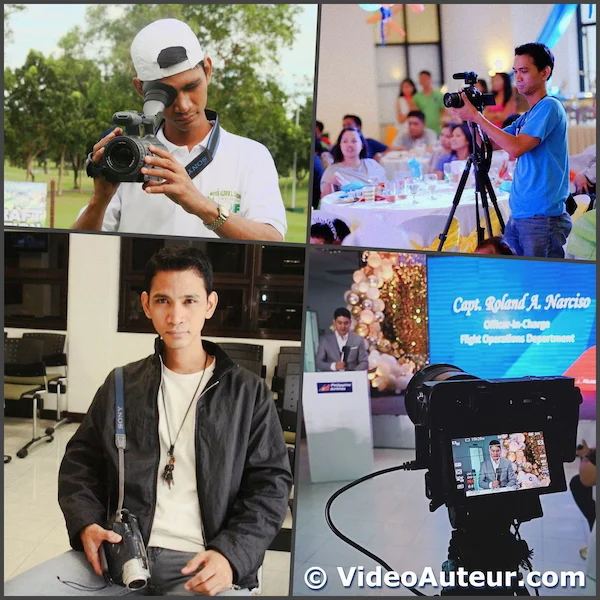 How do you become a videographer: Pictures of me working as a videographer.
How do you become a videographer: Pictures of me working as a videographer.Meanwhile, I learned editing videos -- and continue to improve -- using several consumer and professional video editing software.
And when I shoot and create videos, I do almost all of the tasks I mentioned above.
Here's what I realized...
You can spend years being this videographer whose head is so deep into technical stuff, gear obsession, and the fear of missing out (FOMO).
I know because new shiny objects can be tempting, and I know colleagues who are so infected with this mental state -- especially FOMO.
But I resolved to distance myself from those unnecessary anxieties and adopt a more sensible approach to my work.
Whatever I do as a videographer...
- It's all about communicating and connecting through videos.
- It's about turning raw materials into visual stories that evoke feelings and engage viewers with the subject matter.
Instead of trying to impress by always being flashy, I'm trying to express by being authentic.
How to Become a Videographer: A Roadmap to Develop Your Skills
Concise Roadmap for Beginners:
- Choose Your Learning Path: Start with free/affordable resources (YouTube, Udemy, Skillshare) or consider formal classes if accessible. Mix both for best results.
- Understand Different Roles: Recognize that videography varies (solo shooter, team member, niches like events or docs). Try different styles.
- Start with Essential Gear: Use your smartphone or a basic camera. Add a cheap lav mic, use natural light, and learn free editing software (DaVinci Resolve, iMovie). Master what you have.
- Assess Your Skills: Honestly note what you know, what excites you, and where you need practice. Focus on your passion.
- Explore Career Paths: Consider freelancing, corporate work, documentaries, or creative projects. Starting as a Production Assistant (PA) is a common entry point.
- Build Core Skills: Master these fundamentals:
- Technical: Camera settings (ISO, shutter speed, aperture).
- Storytelling: Structure videos (beginning, middle, end).
- Editing: Practice cutting clips and pacing.
- Sound: Prioritize clear audio (mic placement is key). - Overcome Obstacles: Ignore gear hype, manage imposter syndrome by focusing on growth, prevent burnout with breaks, and set clear client expectations.
Key Beginner Takeaways:
- Start Now: Use the gear you have (phone is fine!).
- Learn by Doing: Practice constantly, even with small projects.
- Focus on Foundations: Master core skills before expensive gear.
- Embrace the Journey: Celebrate small wins, learn from mistakes, and enjoy the process. Progress > Perfection.
So, you’re ready to begin your videography journey—but where do you start? Think of this roadmap as your friendly guide, designed to help you build skills without overwhelm.
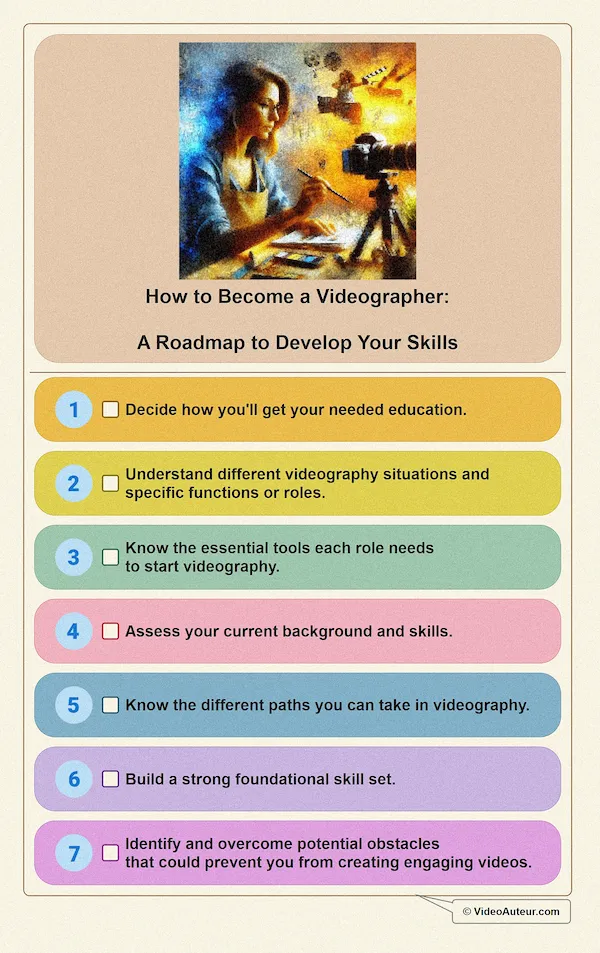 How to Become a Videographer: A Suggested Roadmap.
How to Become a Videographer: A Suggested Roadmap.Whether you’re holding a smartphone or a mirrorless camera, these steps will ground you in the essentials while leaving room for creativity. Let’s break it down together:
1. Decide How You’ll Get Your Education
Formal classes or self-taught? Both paths work!
- Formal education (like film school) offers structured learning and mentorship, which can deepen your technical and theoretical knowledge. But, it’s not mandatory—and it’s okay if it’s not feasible for you.
- Self-guided learning is how many pros start. Dive into free YouTube tutorials, affordable online courses (Skillshare, Udemy), or join videography communities (like Reddit’s r/videography). The key? Stay curious. Practice daily, even if it’s just filming your morning coffee.
- Mix both! Take a weekend workshop or watch a masterclass to supplement your hands-on experiments.
2. Understand Different Videography Situations and Roles
Videography isn’t one-size-fits-all. Your role shifts depending on the project:
- Solo shooter (e.g., filming a friend’s birthday): You’re the director, cinematographer, and sound crew.
- Team member (e.g., a wedding videography team): You might focus on one role, like capturing candid moments as the second camera shooter.
- Specialized niches: Documentaries demand patience and storytelling; corporate videos require clarity and professionalism. Try different styles to find your groove.
3. Know the Essential Tools for Each Role
Gear matters, but it’s not everything—start small.
Basic kit for beginners:
- Camera: Use your smartphone or a used mirrorless camera.
- Audio: A $20 lavalier mic improves sound instantly.
- Lighting: Natural light + a DIY reflector (foam board) works wonders.
- Software: Free tools like DaVinci Resolve or iMovie are perfect for learning edits.
As you grow, invest in tools specific to your niche. For example, event videographers need reliable tripods; documentary makers prioritize portable recorders.
4. Assess Your Current Background and Skills
Take a quiet moment to reflect:
- What do you already know? Maybe you’re great at framing shots but new to editing.
- What excites you most? Editing emotional montages? Capturing live events? Lean into that passion—it’ll fuel your progress.
- Weak spots? No shame here! If lighting confuses you, watch a 10-minute tutorial and practice with a desk lamp. Progress matters more than perfection.
5. Explore Different Paths in Videography
Videography is a vast playground. Here’s a snapshot:
- Freelance: Flexibility + variety (weddings, ads, social content). Ideal for self-starters.
- Corporate: Stable projects like training videos or company profiles. Great if you enjoy structure.
- Documentaries: For storytellers who want to move hearts. Start with short personal projects.
- Creative/Artistic: Music videos, experimental films—unleash your inner artist.
Many aspiring videographers start their journey as Production Assistants (PAs). If you're currently a PA and wondering how to move up...
Learn practical steps and advice on leveraging your on-set experience to launch your videography career.
6. Build a Strong Foundational Skill Set
Master these core skills, and you’ll thrive in any niche:
- Technical: Learn your camera’s settings (ISO, shutter speed, aperture). Practice in different lighting.
- Storytelling: Every video needs a beginning, middle, and end. Film a 1-minute story about your pet or a sunset.
- Editing: Cut clips to a beat, experiment with pacing. Mistakes are okay—they’re how you learn!
- Sound: Clear audio matters more than 4K video. Test mic placements (hint: closer to the subject = better).
7. Identify and Overcome Common Obstacles
We all hit roadblocks—here’s how to navigate them:
- Gear envy: Ignore the “latest and greatest” hype. Master what you own first.
- Imposter syndrome: Even pros feel this! Focus on your growth, not others’ highlight reels.
- Creative burnout: Take breaks. Watch films for inspiration. Remind yourself why you started.
- Client pressures: Set clear expectations. It’s okay to say no to projects that don’t align with your values.
Remember: This is Your Journey
There’s no “right” way to become a videographer—just your way.
Celebrate small wins: nailing a smooth pan shot, editing your first montage, or finally understanding color grading. Keep a notebook of ideas, film often, and don’t forget to enjoy the process.
Skilled videographers aren’t born overnight—they’re built through patience, play, and a whole lot of heart.
Ready for the next step? Let’s dive deeper into each part of the roadmap.
Do Videographers Need a Degree: Formal Education VS Self-Taught
No, you don't need a formal degree to become a videographer.
Key reasons for beginners:
- Many successful videographers are self-taught. Practical experience and using online/resources are valid paths.
- Dedication, passion, and persistence matter more than a degree. Your drive to learn is crucial.
- Formal education can be helpful but isn't required. It provides a foundation, but isn't the only way.
- Continuous learning is essential regardless of your path. You'll always need to practice skills and stay updated on trends and tech.
In short: Focus on building skills, gaining experience, and never stopping learning – you can succeed with or without a degree.
Do you need formal education to become a videographer?
Here's an encouraging truth: Not necessarily!
Yes, formal education in film or video production can give you a solid foundation. It can provide even a deeper grasp of what you're pursuing because of extensive theoretical discussions.
But it's not always necessary.
In the real world, many videographers are self-taught.
According to BYU Marriott School of Business, more and more young people are taking the initiative to teach themselves about video production. This trend is fueled by the increasing demand for video content in marketing.
Even a person with no experience can learn how to become a videographer through practical experience and the right resources.
The key is your dedication to learn, your passion, and your persistence.
You may want to get some formal education, or be a self-guided learner, or both!
Here's what I recommend...
Even if you have already received some formal education in videography, you'll do better if you also become a self-guided learner. Why?
Because I believe learning doesn't have to stop.
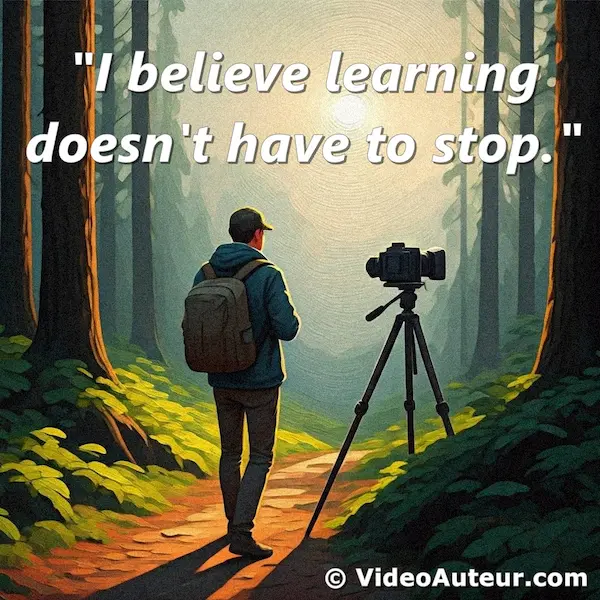 How to become a videographer: Embrace the reality that learning is an ongoing process.
How to become a videographer: Embrace the reality that learning is an ongoing process.In order to grow as a videographer, one needs to understand and continually practice:
- Making compelling shots
- Telling stories through visuals and sounds
- Embracing the latest video-making trends and technology, focusing only on those relevant to your needs.
What equipment do I need to be a videographer? Tailor your gear to your projects and role.
Essential Starter Gear for Beginner Videographers:
- Camera: Start with what you have! A good smartphone is perfectly acceptable. If you prefer a dedicated camera, an old DSLR or a used APS-C mirrorless camera (easier autofocus) is a great affordable step up.
- Audio: Don't neglect sound. Get a basic external microphone (a shotgun mic or low-cost wireless lav mic system significantly improves quality).
- Stability: A sturdy tripod is essential for steady shots.
- Editing: Use free or low-cost software like DaVinci Resolve to edit your videos.
- Storage: Have reliable memory cards and backup storage for your footage.
Key Advice for Beginners:
- Tailor to Your Needs: Your specific projects (hobby, solo work, team role) dictate what gear you really need. Don't buy everything at once.
- Start Simple and Affordable: You DO NOT need the latest, most expensive gear. Use what you have or buy used/affordable options.
- Focus on Storytelling: Viewers care about the content and experience, not technical perfection. Prioritize learning over having "perfect" gear.
- Grow Gradually: Add extras like a versatile zoom lens, prime lens, gimbal, or LED light only as your specific projects require them and your budget allows.
In short: Start with a camera (phone is fine!), a mic, a tripod, editing software, and storage. Choose gear based on your specific video goals and budget, not hype. Focus on creating content!
This one is a little tricky to discuss because there's no one-size-fits all answer to the question, "What equipment do I need to do videography?"
But for beginners, let's make this as simple as possible...
Unlike what you may hear from pure gear review YouTube channels and websites, you don't necessarily have to own the latest equipment.
And you don't have to invest immediately in expensive high-end gear when starting your videography journey.
Here are a few essential tools that you actually need initially:
- A decent camera -- one that can do the job for the types of videos you want to shoot and create
- Basic audio capturing or recording equipment
- A sturdy tripod
- Simple editing software
- Storage solutions for your footage
Now, because different newbies have different needs based on what they specifically want to pursue, let's briefly discuss the following shooting contexts or scenarios.
How can I start videography, particularly as a hobby, and what initial equipment do I need to begin?
How to Start:
- Start Simple: Begin by using the video mode on your smartphone. This is the most accessible and budget-friendly way to practice, especially for things like family videos.
- Progress Gradually: As you learn, you can explore more advanced cameras if you want to.
Initial Equipment You Need:
- Essential Starter: Your smartphone is all you need to begin shooting videos right away.
- Optional Upgrades (If Budget Allows):
- Old DSLR Camera: Good if you enjoy the manual control (like manual focusing) similar to cinematographers. Be aware most lack autofocus.
- Used APS-C Mirrorless Camera: A more user-friendly upgrade with autofocus, easier to handle than a DSLR, and more affordable than professional cameras.
- Lens (For DSLR/Mirless): If you get an interchangeable lens camera, start with a versatile zoom lens like an 18-55mm or 16-50mm.
Key Takeaway for Beginners: You absolutely can start videography as a hobby using just your smartphone. Focus on learning and practicing with what you have.
Fancier equipment like DSLRs or mirrorless cameras are optional next steps if you get more serious and have the budget.
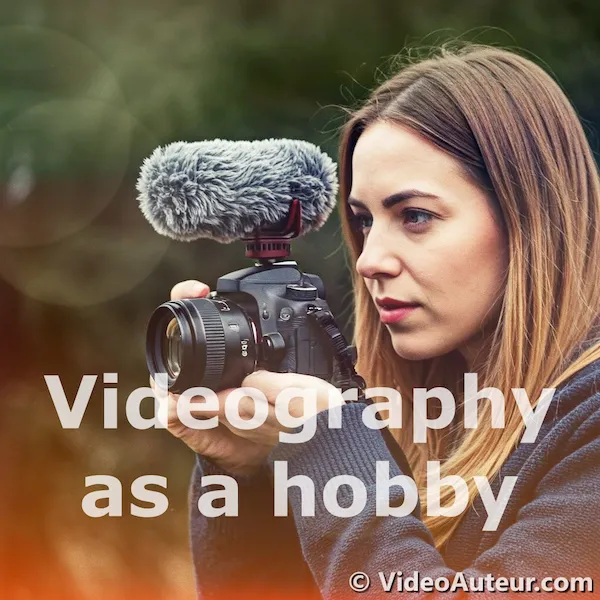 How to Become a Videographer—Videography as a Hobby + Some Beginner Videography Equipment
How to Become a Videographer—Videography as a Hobby + Some Beginner Videography EquipmentIf you want to do videography as a hobby, here are some basic tools to start with...
Camera:
- Smartphone: A good smartphone can work initially. Use its video mode to shoot your videos, especially family videos.
- Old DSLR Camera: You can also use an old DSLR camera, especially if you like shooting like a cinematographer, the person who decides how a movie looks. This means you're okay with focusing manually, which is what many cinematographers do. And since most DSLR cameras don't have an auto-focus system.
(DSLR stands for Digital Single-Lens Reflex. It's a camera that allows you to shoot both photos and videos. A mirror inside the camera reflects the light from the lens to the viewfinder.) - APS-C Mirrorless Camera: If you have the budget, you can get a used APS-C mirrorless camera. It has autofocus technology and is easier to use than a DSLR camera.
(APS-C stands for Advanced Photo System type-C. It's a camera with a sensor size smaller than a full-frame sensor, but larger than the sensors in smartphones and compact cameras. In short, an APS-C camera is a smaller, more affordable version of a professional-grade camera.)
Lens:
- If yours is a DSLR or a mirrorless camera, you may want a versatile zoom lens, like 18-55mm, 16-50mm, or a similar midrange zoom lens.
Some videographers who are hobbyists usually make videos by themselves. If you are that type of video creator, read this guide.
How can a beginner, specifically a solo shooter, get started in videography as a side hustle, and what essential equipment do they need?
How to Start as a Solo Shooter Side Hustle and Essential Gear:
- Get the Core Essentials:
- Camera: Start with an APS-C Mirrorless Camera (great video quality and value).
- Lens: Get one Versatile Zoom Lens (like 18-105mm, 18-50mm, or 17-70mm) for flexibility.
- Sound: Use a Basic External Microphone (shotgun mic or low-cost wireless lav system).
- Stability: A solid Tripod is non-negotiable for steady shots.
- Power/Storage: Spare Batteries and High-Capacity Memory Cards are crucial for long shoots.
- Editing Software: Learn Free/Low-Cost Software like DaVinci Resolve. Mastering editing basics is imperative. - Getting Started Actions:
- Practice: Use your core gear to shoot anything – master your camera settings, framing, and basic editing.
- Focus on Fundamentals: Learn how to get stable shots, good exposure, and clear audio before adding fancy gear.
- Build a Portfolio: Create sample videos showcasing your skills, even if they're personal projects initially.
- Seek Simple Gigs: Look for small, local opportunities (community events, small business promos, basic social media content) where core gear is sufficient.
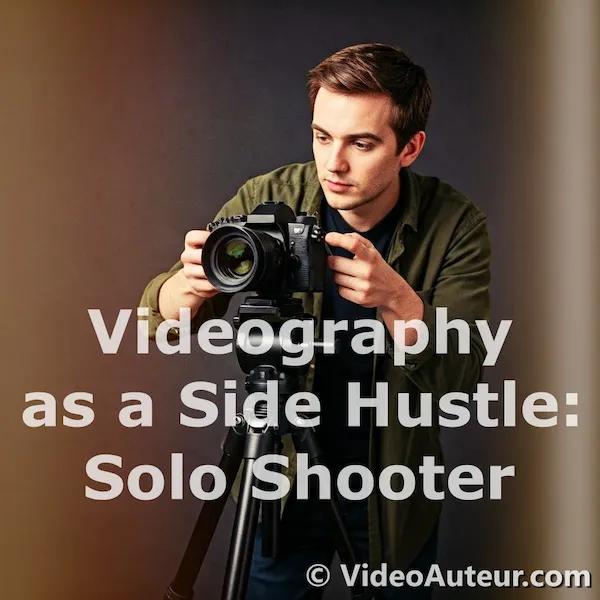 How to Become a Videographer—Videography as a Side Hustle: Solo Shooter + Videography Equipment for Beginners
How to Become a Videographer—Videography as a Side Hustle: Solo Shooter + Videography Equipment for BeginnersIf you want to do videography as a side hustle and you'll be operating as a solo shooter-video creator, here are a few essential tools you'll need...
- APS-C Mirrorless Camera: A great starting point for video shooting.
- Versatile Zoom Lens: Provides flexibility, especially when shooting events. Examples include 18-105mm, 18-50mm, or 17-70mm zoom lenses.
- Basic External Microphone: Improves sound quality. Consider a shotgun mic and/or a low-cost wireless mic system with a lav mic.
- Stable Tripod: Ensures steady shots.
- Spare Batteries and High-Capacity Memory Cards: To ensure that you can continue recording videos, especially during long video shoots or coverage.
- Free or Low-Cost Editing Software: Options that don't require you to pay monthly subscriptions, like DaVinci Resolve.
(Mastering the basics of video editing is imperative for bringing your footage to life and creating professional-looking videos.)
Tools that can follow...
- Prime Lens: A 23mm lens for a classic documentary look or a 56mm lens for video portraiture (both for APS-C). Or any prime lens that you feel can get your creative juices flowing when shooting with it.
- Electronic Gimbal or a Handheld Steadicam: Both can provide very smooth tracking or gliding shots. A gimbal is great for those who prefer the ease of automation, though you'll need to monitor its battery level. A handheld steadicam is ideal for those who want their manual skill to be the sole driving force behind their camera movement.
- LED light: Great for adding some extra light when you're shooting in a studio or controlled setting.
How can a beginner videographer work as a side hustle as part of a team?
Focus on mastering one core team role (like 2nd shooter, creative shooter, or editor) using gear you already have.
Prioritize storytelling and viewer experience over expensive equipment, and seek out teammates who value collaboration and solving problems for the audience.
Key takeaways for beginners from the text:
- Choose a Specific Role: Identify where you fit best in a small team (e.g., main shooter, 2nd shooter, creative shooter, editor). Start with the role matching your current skills/gear.
- Gear is a Tool, Not the Goal: Don't get hung up on having the latest gear. Audiences care about the story and experience, not pixel-perfect tech specs. Master what you own.
- Mindset Matters: Be a problem-solver focused on the human viewer, not just the equipment. Avoid "pixel peeping" and gear envy.
- Find the Right Team: Look for teammates who share this viewer-focused, collaborative mindset rather than being solely gear-obsessed.
This gives beginners clear, actionable first steps: identify their potential role, leverage existing tools effectively, adopt the right collaborative mindset, and find like-minded people to work with.
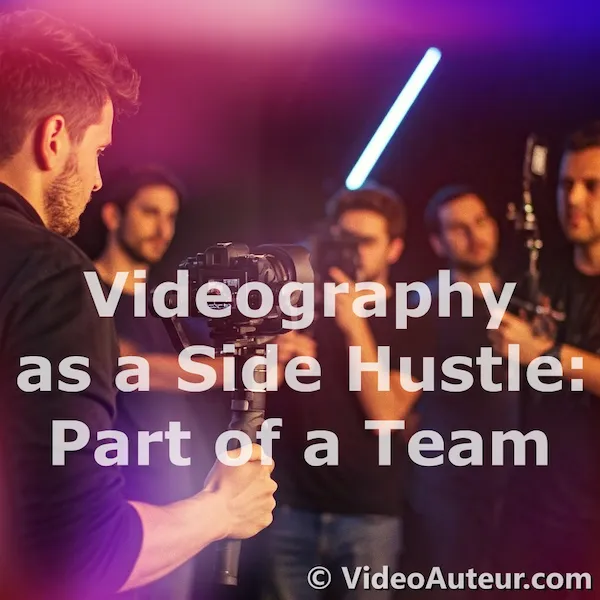 How to Become a Videographer—Videography as a Side Hustle: Part of a Team
How to Become a Videographer—Videography as a Side Hustle: Part of a TeamLet's say you've had many experiences as a solo shooter-video creator, and now you want to work in a small production team. Or perhaps, a need arises for you to operate within a team. What video production tools do you need in this scenario?
The specific tools you'll use will vary, depending on:
- Your specific role in the production team, and
- The kind of teammates you have
--
First, let's tackle the kind of teammates you have...
Your ideal teammates would be problem solvers who are open-minded and human-focused. They care more about what human viewers will experience as they watch the video than the gear they use.
For the team members, it's not about having the latest and best gear, but knowing how to effectively use what you have to serve the viewers.
They acknowledge that human audiences do not "pixel peep" at the footage, unlike many photographers and video shooters. Audiences are there to get a positive experience from watching the video.
Research studies indicate that average viewers are more concerned with the overall viewing experience than scrutinizing technical details. This suggests that the context and content of the video are more important to the audience than resolution or pixel quality.
In other words, audiences value storytelling and emotional engagement over minute technical details.
However, my experiences in dealing with other shooters tell me that many are still very gear-oriented. They cannot move past being gear heads to becoming communicators who simply use gear as tools.
They're still affected by the fear of missing out. I have a colleague who felt left behind simply because his mirrorless camera is APS-C, not full-frame. I felt sorry for him because I believe it's about making the most of what you have and using your tools properly.
--
Now, let's talk about some possible roles you may take on in a small production team and the essential tools you could use...
In a small production team, each role is crucial to the success of a project. Here are the four key positions:
- the main camera shooter
- the second camera shooter
- the creative camera shooter, and
- the video editor
After discussing the specific responsibilities of each role, we'll break down the essential tools for each one...
What do I need to know and acquire to start working as the primary ("main") camera operator ("shooter") in video production?
What You Need to KNOW:
- Capture Essential Action: Focus on filming the critical moments and main story of the event/production.
- Drive the Core Narrative: Your shots are the primary storytelling tool.
- Coordinate the Team: Work with other shooters, potentially guiding their positioning and shot timing for cohesive coverage.
What You Need to ACQUIRE (Essential Gear):
- Main Camera: A mirrorless camera (APS-C or Full-Frame) without a recording time limit.
- Primary Lens: A versatile zoom lens (e.g., 18-105mm for APS-C, 24-105mm for Full-Frame).
- Sturdy Tripod: With a fluid head for smooth pans and tilts.
- Audio Essentials:
- Shotgun microphone (on-camera for general sound).
- Wireless lavalier mic system (for interviews/presentations).
- Optional but helpful: Dedicated audio recorder. - Monitoring: Earphones/headphones to check audio quality during recording.
- Power and Storage: Multiple spare batteries and high-capacity memory cards.
- Basic Lighting: A simple LED light panel for controlled lighting situations.
Key Takeaway for Beginners: Master capturing the main story while coordinating with others. Start with the core gear listed above (especially the camera, lens, tripod, basic audio, batteries/cards) and build your skills and kit from there.
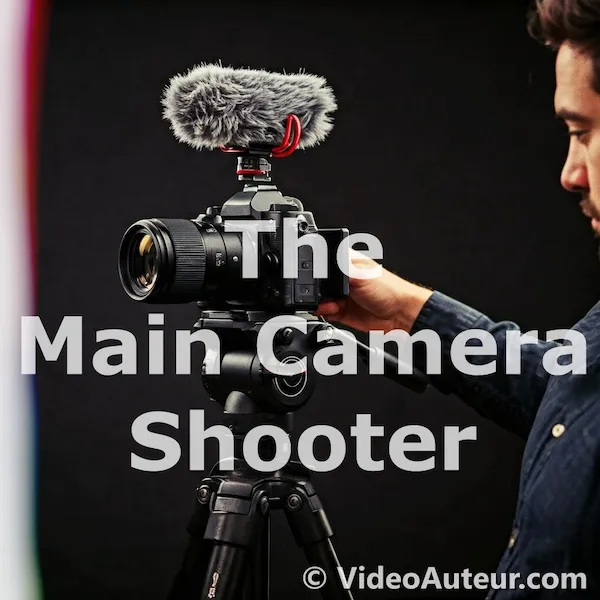 How to Become a Videographer: The Main Camera Shooter + Equipment Needed for Videography
How to Become a Videographer: The Main Camera Shooter + Equipment Needed for VideographyThe "Main Camera Shooter" typically:
- Captures essential, must-have moments or the main action of an event.
- Takes responsibility for the primary narrative, or core storytelling.
- Coordinates with other shooters.
- Can also decide on the positioning of other shooters and the timing of their shots for harmonious teamwork.
--
Essential tools of a main camera shooter include:
- Main Camera: A mirrorless camera--either an APS-C or a full-frame camera--that doesn't have video recording limit, which is ideal for long takes or extended video recordings.
- Primary Lens: A versatile zoom lens for flexibility in various shooting scenarios. Like 18-105mm, 17-70mm, or 18--50mm (for APS-C camera). Or 24--105mm, 24--70mm, or 28--75mm (for full frame camera).
- Tripod: A sturdy tripod with fluid head for smooth panning and tilting shots.
- External Microphone: A shotgun mic on camera for general audio capturing. Also, a wireless lavalier mic system for shooting interviews, messages, and on camera presentations. An audio recorder can also come in handy especially for voice over recordings and other dedicated sound recordings.
- Earphones: For sound monitoring, especially when covering speeches, interviews, messages, and on-cam presentations.
- Spare Batteries and High-Capacity Memory Cards: To ensure no interruptions during long video shoots.
- Basic Lighting Kit: Like a simple LED light panel for controlled lighting in various settings.
What do I need to know and acquire to start working as a "second camera" operator in video production, and what's the difference from the main shooter?
What You Need to KNOW (The Role and Difference):
- Your Job: Capture complementary footage to the main shooter: alternative angles, candid reactions, secondary events, and B-roll.
- Key Difference from Main Shooter:The Main Shooter focuses on the primary action/subject.You (Second Shooter) focus on supporting angles, reactions, and secondary coverage.
- Crucial Skill: Work in coordination with the main shooter and director.
What You Need to ACQUIRE (Essential Gear):
- Camera: A mirrorless camera (APS-C or Full-Frame).
- Lenses:
- Telephoto Zoom: (e.g., 55-200mm APS-C / 70-200mm Full Frame) for reactions and tight shots.
- Standard Primes: (e.g., 23mm/33mm APS-C / 35mm/50mm Full Frame) for B-roll, interviews, low light. - Support: A sturdy tripod (stable angles) and/or monopod (mobile reactions).
- Essentials: Extra batteries, high-capacity memory cards, and earphones (monitor audio).
- Sound: An external mic (shotgun on camera) or simple wireless lav system.
- Light (Optional but Recommended): A portable LED light for fill or small setups.
In short: Know your role is to capture supporting footage (angles, reactions) in sync with the main shooter.
Acquire a capable camera, key lenses (zoom + prime), support gear, audio basics, and essential accessories.
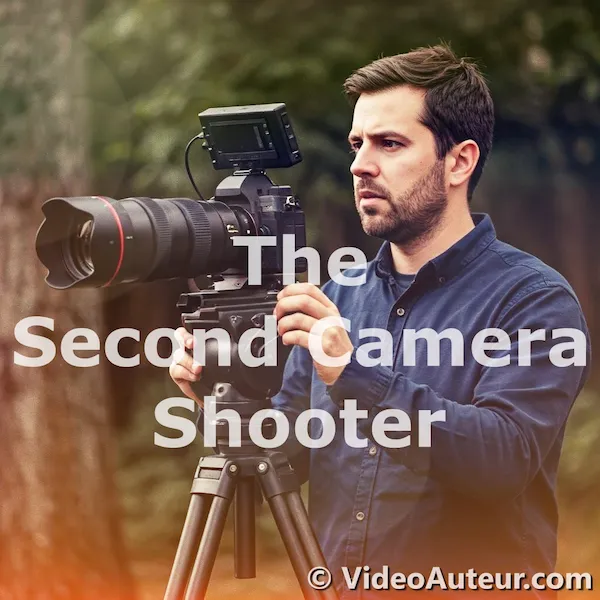 How to Become a Videographer: The Second Camera Shooter + Equipment Needed for Videography
How to Become a Videographer: The Second Camera Shooter + Equipment Needed for VideographyA "Second Camera Shooter" takes on a support role that:
- Provides alternative angles of the main action that complement the shots of the main camera.
- Captures candid reaction shots of people to the main action.
- Covers secondary events happening simultaneously to provide other perspectives.
- Works in coordination with the main shooter.
--
A second camera shooter typically uses:
- Secondary Camera: A mirrorless camera--either an APS-C or a full-frame camera--to capture additional perspectives on the main action and supplementary shots (B-roll footage).
- Secondary Lenses: A telephoto zoom lens to complement the main camera shots. Especially useful when capturing candid reaction shots. Lenses like 55-200mm (APS-C), or 70--200mm (full frame). Standard prime lenses with wide apertures to let more light reach the camera sensor can also come in handy, especially in low-light situations. Primes like 23mm and 33mm (for APS-C), or 35mm and 50mm (for full-frame) are useful for shooting B-roll, interviews, and other talking head stuff.
- Secondary Tripod or Monopod: A sturdy tripod for stable extended coverage from additional angles. A monopod for mobility, especially when you need to quickly shoot candid moments and reaction shots from different viewpoints.
- Batteries and High-Capacity Memory Cards: For uninterrupted shooting and storing footage.
- External Mic and/or Wireless Microphone System: This could be a simple shotgun mounted on the secondary camera for general sound capturing. Or a simple wireless mic system with a lavalier mic for shooting other needed interviews or messages.
- Earphones: For audio monitoring.
- Portable LED Light: For additional lighting in dim areas and in controlled shooting environments.
What exactly is "The Creative Camera Shooter" role in videography, what responsibilities does it entail, and what specific equipment is necessary for someone in this role to produce visually innovative and artistic video content?
- What is it?
- A specialized role focused on capturing artistic, unique, and supplementary footage to add visual flair and creativity to a video project (like events, films, or commercials). - Key Responsibilities:
- Find Unique Angles: Seek out unexpected perspectives and creative compositions.
- Capture Details and Ambiance: Shoot close-ups (rings, food, textures) and atmospheric moments that set the mood.
- Shoot Beauty/Glamour Shots: Create visually pleasing portraits of key people, similar to portrait photography.
- Experiment: Have more freedom to try different shooting styles, techniques, and movements.
- Enhance, Don't Dominate: Provide shots that complement the core story shot by the main camera operators, not replace it. - Essential Equipment:
- Camera: A mirrorless camera (APS-C or Full Frame) capable of high frame rates (60fps, 120fps+) for smooth slow-motion.
- Lenses:
- [1] Wide-Angle Lens: For immersive, unique perspectives (e.g., 10-18mm APS-C, 16-35mm Full Frame).
- [2] Portrait Lens: For flattering beauty/glamour shots (e.g., 50mm/56mm APS-C, 85mm Full Frame).
- [3] Macro Lens: For extreme close-ups of small details (e.g., 60mm APS-C, 100mm Full Frame).
- Electronic Gimbal: For creating smooth, dynamic, moving shots, especially when combined with slow motion.
- Wireless Microphone: To capture clear audio from subjects when needed.
Key Takeaway for Beginners: The Creative Camera Shooter is the "visual experimenter" on a team, using specific gear to capture stunning, artistic shots that support the main story.
Their strength is adding unique visual spice, but the core narrative relies on the main camera operators. It's a role balancing creativity with teamwork.
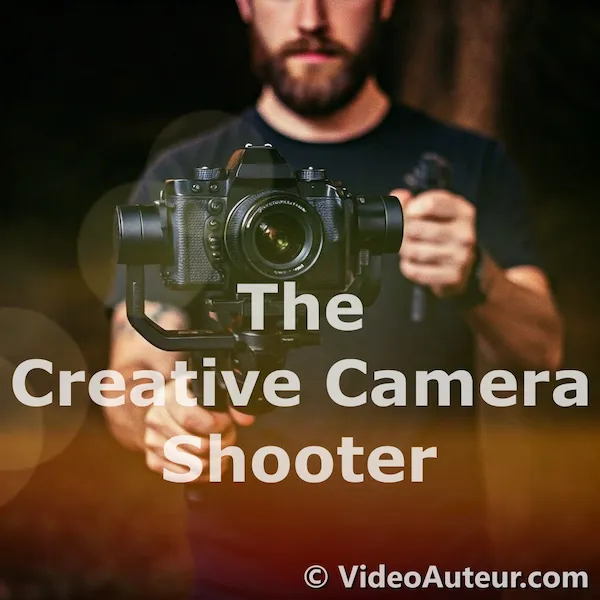 How to Become a Videographer: The "Creative Camera Shooter" Role + Equipment Needed for Videography
How to Become a Videographer: The "Creative Camera Shooter" Role + Equipment Needed for VideographyA "Creative Camera Shooter" primarily captures artistic, unexpected, and supplementary footage that adds creative flair to the final video. Here are their main functions:
- Looks for unique angles and creative compositions.
- Captures detail shots and ambient moments.
- Shoots beauty and glamour shots of key persons in an event, just like what portrait photographers do.
- Has more freedom to experiment with different shooting styles or techniques.
- Uses different tools like gimbals, macro lenses, or drones.
--
A creative camera shooter typically works with:
- Creative Camera: A mirrorless camera--either APS-C or full frame--with high frames per second (FPS) capabilities (60 fps, 120 fps, or higher). Usually used for shooting slow motion footage.
- Wide-Angle Lens: Could be a wide-angle prime lens like 16mm (APS-C), or an ultra wide-angle prime like 11mm (APS-C). Could also be an ultra wide-angle prime like 20mm or 17mm (full frame). You could also go with a zoom lens with moderately wide to ultra-wide range--like 10--20mm or 10--18mm (APS-C). Or 16-35mm and 17--28mm (full-frame). The ultra wide perspective contributes to that unique immersive look to some of the shots in the final video.
- Prime Lens: A portrait lens for beauty and glamour shots. Like 50mm, 56mm, or 75mm (APS-C), or 75mm, 85mm, 135mm (full-frame). A macro lens for shooting extreme close ups of key objects like wedding rings and food ingredients, or body parts like lips and eyes. There's 60mm or 40mm (for APS-C) and 100mm or 90mm (for full frame).
- Electronic Gimbal Stabilizer: For dynamic movement shots, especially when combined with slow motion.
- Wireless Microphone System: A simple wireless mic system, the transmitter of which has a built-in mic for capturing clear audio from a distance.
Visual experimentation should enhance, not overshadow, the story.
The term "creative camera shooter" doesn't mean that the main camera and the second camera shooters are not doing creative work. They certainly are!
In fact, creativity in videography is all about solving the problem of giving the intended viewers an overall positive viewing experience when watching the video. And you can't just credit that to the "creative camera shooter".
It's teamwork, remember.
Creative camera shooters are granted more freedom to experiment with the visual look of their shots.
The main and second camera shooters prioritize reliability and consistency over experimentation to ensure the core narrative is conveyed.
Creative camera shooters, focusing on experimentation, can quickly capture unique and visually interesting shots for the final edit.
The truth is, if the majority of shots come from the "creative camera shooter", the final edit will feel lacking in substance. It will lack meaning and sincere emotions.
I have some colleagues who prefer that kind of final edit. They're photographers, by the way, not videographers or visual storytellers. The result, sometimes, is that clients are still looking for those key event moments that my colleagues didn't include in their final edit.
You may have seen videos with many visually impressive shots and camera movements, especially gimbal shots. But somehow they feel like a bunch of random stuff put together like a stills slideshow.
That's because those shots lack the motivating core story that will hold them together and give them heart, soul, and meaning.
In short, the main camera, the second camera, and the creative camera shooters all do creative work. They just do it, well, in their own unique creative ways.
The core narrative and emotional impact of a video depend on a balance between creative experimentation and solid storytelling.
How can I become a videographer who specializes in video editing, what does that role entail, and what essential equipment (including software and hardware) will I need to perform video editing effectively?
1. How to Become a Videographer Specializing in Video Editing:
- Learn: Master core editing skills (cutting, sequencing, pacing) through online courses, tutorials, and practice.
- Practice: Edit constantly using free/beginner software. Build a portfolio with personal projects.
- Specialize: Focus on "video editing" as your core service within videography.
- Seek Experience: Volunteer, intern, or take small freelance gigs to gain real-world experience.
2. What the Video Editor Role Entails:
You shape the raw footage into the final story. Your core tasks include:
- Importing and organizing footage.
- Creating the edit (rough cut, fine-tuning cuts, pacing).
- Adding visuals (effects, titles, graphics).
- Editing and mixing audio (dialogue, sound effects, music).
- Color correcting/grading for a consistent look.
- Exporting the final video in the right format.
- Collaborating with the team/client and incorporating feedback.
3. Essential Equipment for Effective Video Editing:
- Hardware:
- Powerful Computer: A high-performance desktop (ideal) or laptop (for portability) is non-negotiable. Consider a UPS for desktops.
- External Hard Drives: Crucial for storing footage and backups.
- Card Reader: To import footage from camera SD cards.
- Quality Headphones (or earphones): Essential for accurate audio editing.
- Protective Case (for laptop/mobile gear): For safe transport. - Software:
- Professional Editing Software: Choose one primary tool: DaVinci Resolve (Free/Paid), Adobe Premiere Pro, or Apple Final Cut Pro. These handle core editing, color, and often include basic audio/graphics tools.
- (Often Included): Audio Editing: Software like Fairlight (in Resolve) or Audition (Adobe) might be included or integrated.
- (Often Included): Motion Graphics: Basic tools like Fusion (Resolve) or After Effects (Adobe) might be included for titles/effects.
Key Takeaway for Beginners: Start learning core editing skills with free software (like DaVinci Resolve Free). Practice relentlessly on any computer you have, adding external storage and headphones first.
As you progress, invest in a more powerful computer and potentially paid software.
Focus on mastering your primary editing tool – its built-in features often cover audio and basic graphics needs initially.
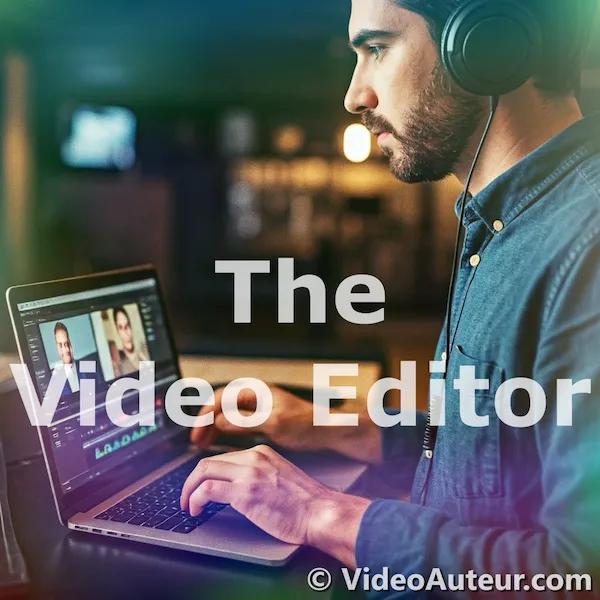 How to Become a Videographer: The Video Editor + Equipment Needed for Videography
How to Become a Videographer: The Video Editor + Equipment Needed for VideographyA "video editor" in a small production team plays a crucial role in shaping the final output of a video project. Here are their main functions:
- Imports all the raw footage shot by the video shooters into the editing software; organizes the clips into folders and bins.
- Creates a rough cut by arranging clips in the desired sequence; fine-tunes it by trimming clips and making precise cuts to improve flow and pacing.
- Adds relevant visual effects to enhance the footage; incorporates needed titles and graphics.
- Edits sound to ensure dialogue and sound effects match the footage; adjusts levels and mixes the audio tracks to create a balanced and polished soundscape.
- Ensures consistent exposure and a cohesive look that aligns with the project's vision by color correcting or color grading.
- Exports the final video in the required format and resolution; handles needed revisions based on feedback from the client.
- Works closely with other team members to ensure the final video aligns with the creative vision; solves technical issues that arise during the editing process.
--
A video editor needs:
- High-Performance Computer: To ensure smooth editing workflow. This could be a powerful desktop computer--better if with Uninterruptible Power Supply (UPS). Or a powerful laptop--for those who often travel and those who do same-day edits in different places.
- Powerful Editing Software: For professional video editing. Examples include DaVinci Resolve, Premiere Pro, and Final Cut Pro.
- External Hard Drives: For ample storage and backup of footage.
- Card reader: For copying files from the SD cards of video shooters.
- Good Quality Headphones or Earphones: For precise audio editing and sound mixing.
- Audio editing software: For detailed audio editing and enhancement. But this can already come with your powerful editing software of choice. Examples include DaVinci Resolve's Fairlight and Adobe's Audition.
- Basic motion graphics software: This can also come with your powerful editing software of choice. Examples include DaVinci Resolve's Fusion and Adobe's After Effects. Or a separate motion graphics software depending on the kind of graphics you need to create.
- Hard case or protective gear: For transportation of your powerful laptop and other video editing tools.
Blurring Roles in Small Production Teams and Becoming the Ultimate Video Auteur
In smaller production teams, the lines between these roles can often blur...
For example, I've been with some teams that only have 2 video shooters and 1 video editor.
I usually take on the role of the main camera shooter, focusing on the core narrative. However, I sometimes also shoot some details, ambient moments, and beauty shots--the job of a creative camera shooter.
The other videographer, the creative camera shooter, sometimes also shoot alternative angles of the main action and candid reaction shots--the second camera shooter's job.
However as a solo-shooter video creator...
I wear different hats, as I'm expected to perform multiple roles to produce an engaging final video.
In my case, I prioritize capturing the core narrative of an event or project, which is the heart and soul of the video.
That's the role of the main camera shooter.
But I also capture supplementary shots that add visual interest to the video, such as ambient shots, details, beauty shots, and even some macro shots.
That's the role of the creative camera shooter and I'm usually able to do this before the main program of an event starts.
And sometimes, in the middle of an event's program doing the main camera shooter's role, I quickly transition to being a second camera shooter. How?
By capturing reaction shots from the crowd. I also get some candid shots during the inactive parts of an event, when there's not so much happening on stage.
Finally, in the post-production stage, I do the video editor's role, organizing footage, selecting shots, piecing together the golden parts to create the final edit.
As you can see, the single video shooter's tasks are more challenging, but emotionally rewarding in the end.
You become the ultimate video creator. You become the absolute video auteur.
How do I get started in videography? Understand your starting point.
Begin by honestly assessing your current skills, interests, and background. Identify what you already know (like photography, editing, storytelling, tech comfort, or social media experience) and what you need to learn.
This self-awareness helps you focus your learning and leverage your strengths right from the start.
How do you get started in videography?
Understand your starting point.
Why?
So that you'll be aware of your existing strengths and weaknesses. You'll know what to capitalize on and you'll know what to improve on.
People who decide to become videographers come from different backgrounds. Here are a few typical backgrounds:
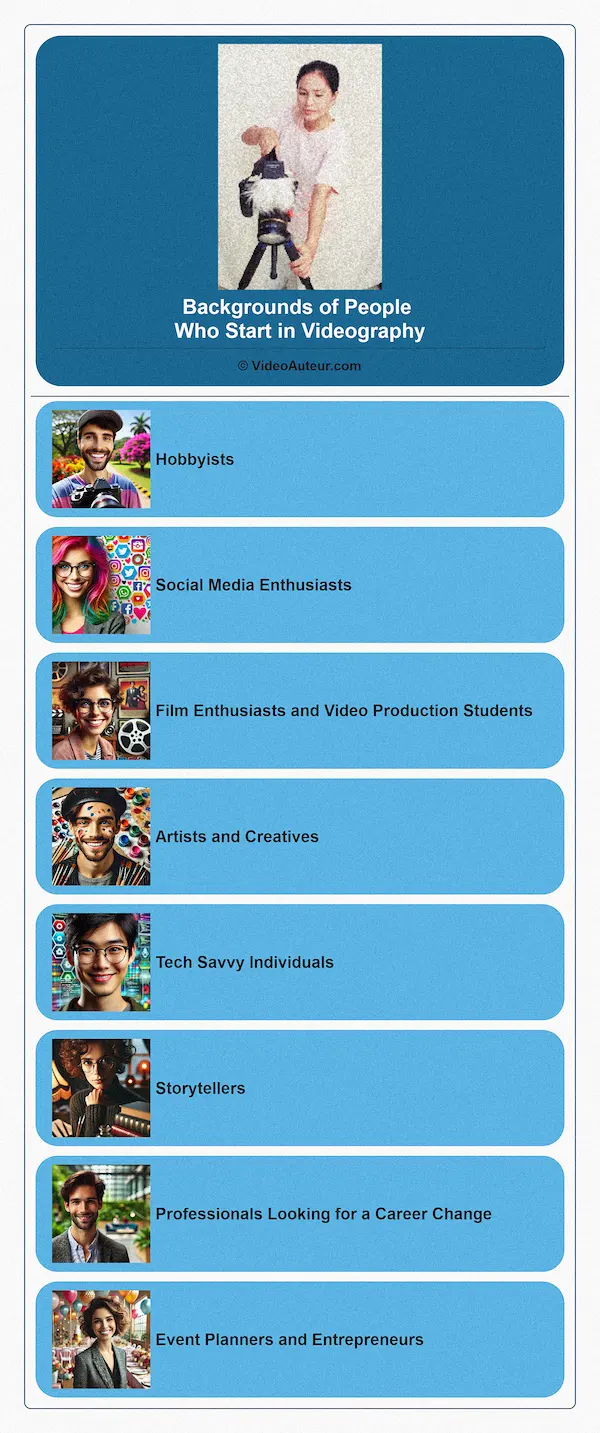 How to Become a Videographer: Exploring the Backgrounds of Those Who Start in Videography.
How to Become a Videographer: Exploring the Backgrounds of Those Who Start in Videography.Hobbyists: People who start out shooting family events, their hobbies, or vacations and then fall in love with it. They also try to learn editing their videos.
Social Media Enthusiasts: Individuals who enjoy using social media platforms like YouTube, Instagram, Tiktok, or Facebook, and want to start creating vlogs or tutorials. They want to gradually hone their skills in videography.
Film Enthusiasts and Video Production Students: People passionate about movies and filmmaking are drawn to the technical and artistic aspects of videography. Also, some former students start with artistic aspirations, but later find commercial videography to be more sustainable.
Artists and Creatives: People with a background in forms of visual art--like graphic design or photography--and who want to expand their skills to include moving images.
Tech Savvy Individuals: People who love playing with gadgets and technology and are comfortable with software. They often get into videography to explore their interests in using cameras for shooting and editing software for post-production tasks.
Storytellers: These are writers, journalists, or anyone with a strong storytelling urge. They find videography to be a powerful way to convey their narratives and connect with viewers.
Professionals Looking for a Career Change: They are individuals in unrelated fields who discover a passion for video making and decide to make a career switch.
Event Planners and Entrepreneurs: Those who organize parties, weddings, corporate events, or other gatherings often start shooting videos to document these occasions. They later realize they have a knack for it. Also, some people see videography as a business opportunity and start their own production companies.
Which path in videography is right for me?
There's no single "right" path. Explore these main options to find what fits YOU best:
- Freelance: Diverse projects (events, social media, promos). Offers flexibility.
- Corporate: Stable work creating training videos, demos, and marketing materials. Offers stability.
- Event: Focus solely on weddings, conferences, sports. Suits those who love action and travel.
- Documentary: Tell impactful stories (non-profit, passion projects). Driven by passion and storytelling.
How to choose? Think about what you value most: flexibility, stability, fast-paced action, or meaningful storytelling. Try different types of projects to discover your fit!
Before you decide to become a videographer, it's important to understand your background and think about the direction you want to take.
Videography offers diverse paths. Try to explore these avenues to find what resonates with you...
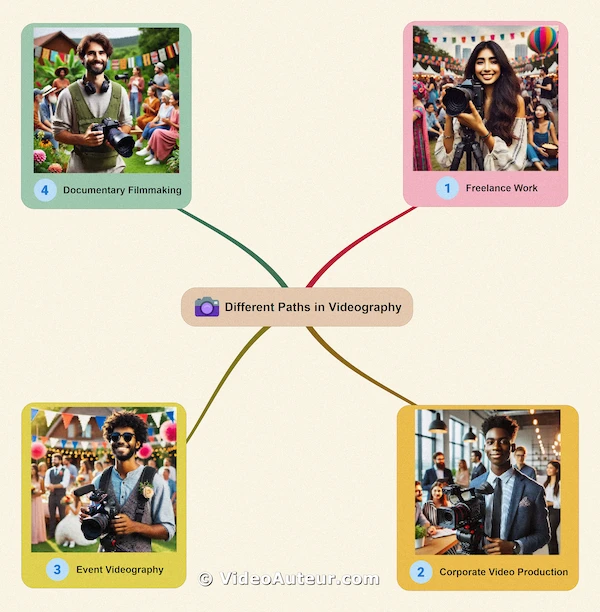 How to Become a Videographer: Exploring Different Paths in Videography.
How to Become a Videographer: Exploring Different Paths in Videography.Freelance Work: You work independently on various projects, including event coverage, social media content, and small business promotional videos.
Freelance work offers flexibility.
Corporate Video Production: Joining a corporate video production team offers stability, unlike freelance work. Many businesses need internal training videos or promotional content.
As a corporate videographer, you create product demos, training videos, company profiles, and marketing materials.
Event Videography: Specialize in capturing special events like weddings, conferences, sports events, and parties. Unlike freelancers who are jacks-of-all-trades, event videographers focus solely on events.
This path suits those who love action and frequent travel.
Documentary Filmmaking: This path allows you to delve deep into stories that matter. If you’re passionate about storytelling, documentaries can make a significant impact.
Projects can include independent productions, non-profit work, and personal passion projects.
Though it may be less popular, it allows you to inform and inspire through short or long-form documentaries, often driven by passion over profit.
What does it take to be a videographer? Build your foundation.
To build your foundation as a videographer, master these core skills regardless of your equipment:
- Technical Skills:
- Camera Operation and Settings
- Lighting Principles
- Audio Capturing and Recording - Organizational Skills:
- File Management - Creative Skills:
Composition Basics
Storytelling and Narrative Structure
Video and Audio Editing Fundamentals
Focus on mastering these fundamentals first – they are essential for any videographer, even before upgrading gear.
I think the key to building your videography foundation—or growing your videography skills—is to learn the basics of video making until you master it.
And remember, the journey of learning and growing never ends... Keep learning and growing as long as you live. 😉
--
Aspiring videographers need to learn the following, regardless of gear:
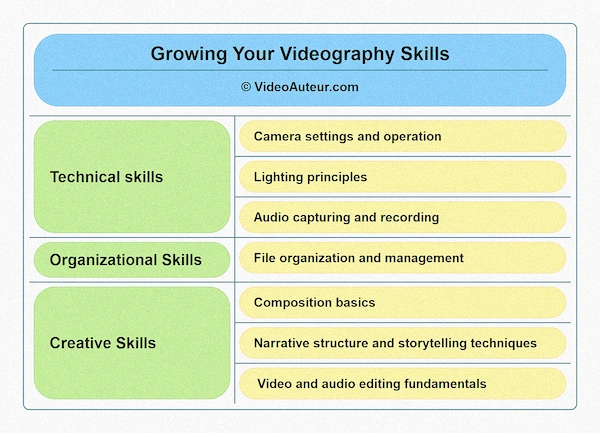 How to become a videographer: Learn and develop these essential videography skills.
How to become a videographer: Learn and develop these essential videography skills.--
Technical Skills:
- Camera settings and operation (depends on the specific camera you have)
- Lighting principles
- Audio capturing and recording
Organizational Skills:
- File organization and management
Creative Skills:
- Composition basics
- Narrative structure and storytelling techniques
- Video and audio editing fundamentals
Video Key Takeaways—Videography Basics

Key points in this video include...
Frame Rate Fundamentals:
- 24fps is the cinematic standard for playback, offering a natural motion feel.
- Capture vs. Playback Frame Rate: Higher capture frame rates (e.g., 60fps or 120fps) enable slow motion when played back at 24fps (e.g., 60fps becomes 2.5x slower, 120fps becomes 5x slower).
- Timeline Recommendation: Beginners should start with a 24fps timeline for a cinematic foundation.
Shutter Speed and Motion Blur:
- Follow the 180-Degree Shutter Rule: Set shutter speed to double your frame rate (e.g., 1/50th sec for 24fps) for natural motion blur.
- Deviating from this rule (e.g., faster shutter for crisp action, slower for blur) is advanced but possible for creative effects.
ND Filters for Exposure Control:
- Use ND filters (like "sunglasses" for your lens) to reduce overexposure when shutter speed and aperture are locked for creative reasons (e.g., maintaining bokeh or motion blur).
Audio Importance:
- Audio quality is critical—poor sound is less forgivable than poor video.
- Microphone Types: Shotgun mics (directional, ideal for vlogging), lavalier mics (discreet for voices), and others suit different needs. A basic shotgun mic is a solid starting point.
Camera Movement Basics:
- Basic Movements: Pan (horizontal), tilt (vertical), push-in (emphasize subject), pull-out (reveal scene). Experiment with tracking or dolly shots as skills grow.
- Movement enhances storytelling; start simple and focus on intentional motion.
Actionable Insights:
- Start with 24fps timelines for a cinematic look. Use higher frame rates (60/120fps) for slow-motion effects.
- Set shutter speed to 1/(2x frame rate) (e.g., 1/50th sec for 24fps) for natural motion blur.
- Invest in ND filters to manage exposure without compromising aperture/shutter settings.
- Prioritize audio quality: Begin with an affordable shotgun mic and upgrade as needed.
- Practice basic camera movements (pan, tilt, push/pull) to add dynamism to shots.
Final Takeaway: Master these fundamentals (frame rate, shutter speed, audio, movement) to build a strong videography foundation, then explore advanced techniques like lighting and post-production.
What are the common mistakes or challenges that aspiring videographers should be aware of and try to avoid?
- Forgetting Your Audience: Focusing solely on making the video, not on whether it engages viewers.
- Gear Obsession: Prioritizing cameras/equipment over developing storytelling skills and creativity (gear is a tool, not the goal).
- Negative Peer Influence: Surrounding yourself only with people focused on gear/trivialities, not audience connection.
- Unhealthy Comparison: Constantly comparing yourself to others (skills, gear) breeds insecurity. Focus on your work.
- Relying on Formulas: Using rigid templates (same music, structure for every project) kills creativity and audience connection.
- Prioritizing Look Over Substance: Spending excessive time on color grading/effects while neglecting content flow and audience reaction.
- Rushing the Process: Not allowing enough time for creative thought, intuition, and careful refinement leads to weak results.
Key Takeaway for Beginners: Focus first on engaging your audience through strong storytelling and meaningful content.
Use gear wisely, avoid distractions like comparison or formulas, and give your work the time it needs.
Your unique perspective matters more than having the fanciest tools.
Okay, we've talked about how to become a videographer.
However, there are obstacles that can hinder videographers from making good videos. Awareness of these problems is essential to solve them.
--
So, here are some obstacles that I encountered myself as a videographer... and that you may encounter as well... reasons why we may find it hard to make engaging videos.
Do you recognize any one of them?
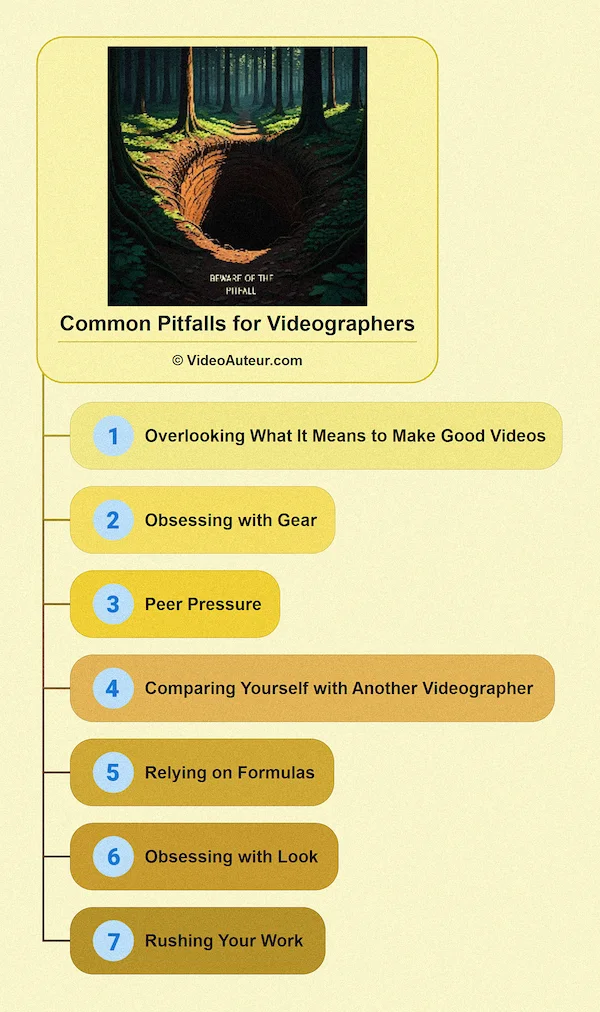 How to become a videographer? Overcome the obstacles that can hinder you from creating great videos.
How to become a videographer? Overcome the obstacles that can hinder you from creating great videos.Overlooking What It Means to Make Good Videos
Our desire is to create videos, right? But it's not mediocre videos that we want to make.
A good video is simply one that engages the viewers. If we forget the viewers in our creation process, our videos will fail to become good presentations.
Because to make a good video is to focus and to jump into the process of “making it”, while keeping an eye on your audience.
Obsessing with Gear
I see many videographers who put so much importance on equipment. They feel more excited to talk about cameras, lenses, software, and latest gadgets than to talk about improving craft and creativity.
It’s not that gear doesn’t matter, but gear becomes an obstacle if treated as the end rather than as tools.
Creating good videos is already challenging. If that’s really your goal, you need to feel more enthusiastic about the practice of “doing it” than anything else.
Your camera won’t tell your story—only you can. Are you chasing gear or creating art?
Peer Pressure
Peers are helpful if they share the same direction you're heading.
If you associate with people who are into the communication aspect of making videos, I think you’ll find it easier to make videos that connect with your audience.
But, if you hang out more with gear-oriented fellows, you’ll be having a hard time hitting your goal. Because you’ll be influenced to pay attention to trivial matters of video production.
Comparing Yourself with Another Videographer
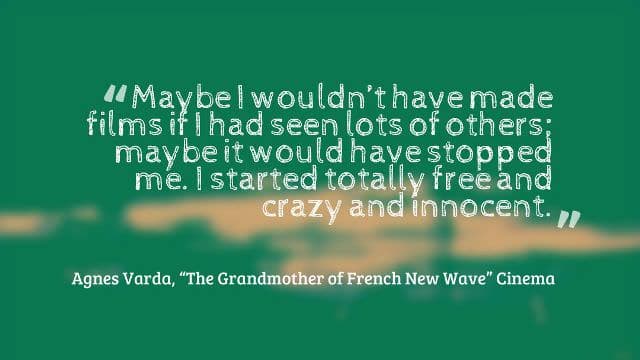
You’ll find it hard to make good videos if you’re always comparing yourself to other videographers.
If you’re doing that, you’re just triggering your feeling of insecurity. And you say to yourself, “There are videographers out there who are better than me, and who have better gear than me.”
Well, that might be true! But does it mean you're not in any way capable of producing your own works that viewers will appreciate, regardless of your gear? You can make your original, engaging videos.
So, instead of hurting your ego by making needless comparisons, it’s better to...
- put your blinders on,
- mind your own project, and
- do your own thing silently.
As Agnes Varda, “The Grandmother of French New Wave” Cinema, once said...
“Maybe I wouldn’t have made films if I had seen lots of others; maybe it would have stopped me. I started totally free and crazy and innocent.”
Relying on Formulas
“Formulas” are strict patterns about what elements to include, and where to place them in your video presentations. It’s like a recipe whose ingredients and proportions never change.
An example is using the same songs and placement of those songs for different wedding videos.
I remember back then when a friend paid me to edit videos he shot from different weddings. He even told me to use the same list of songs for all those wedding videos. :-l
Formulas don’t work well for engaging viewers because every project has its own audience with unique concerns.
And formulas restrain you from thinking creatively about how to cater to your viewers’ needs.
Obsessing with Look
If you put so much time and effort into the external look of your video, that can get in your way of making better videos. Why?
It's the internal dynamics—'the inner workings'—that connect with your audience more than the external look—'the packaging'.
The look of your video--color grading, effects, graphic design, widest "dynamic range" possible--may be impressive.
But, if you underestimate your video’s internal dynamics--the content, the flow of ideas, and audience reaction-- your presentation will just barely engage the audience.
Rushing Your Work
Making good videos is no different than other creative endeavors. It takes time, thought, intuition and care.
If you rush it, you may not recognize your own creative impulses that give freshness to your video... and you may fail to notice the faults in your presentation.
So, take your time and enjoy your work. :-)
How do I build connections to grow my network and find clients in video production?
How to Build Connections & Find Clients as a Beginner:
- Start Small and Local: Offer free video services to friends/family for events, or volunteer for small nonprofits/schools/local events. This builds your portfolio and visibility.
- Showcase Authentically Online: Pick one social platform (e.g., Instagram, TikTok). Post your work clips, share behind-the-scenes stories/challenges, and genuinely engage with others (comment, celebrate peers).
- Collaborate: Team up with other creatives (photographers, musicians) on passion projects. Join online video communities (Reddit, Facebook groups) to ask questions and connect.
- Attend Local Events: Go to film festivals, workshops, or business meetups (like Chamber of Commerce). Focus on listening, learning, and sharing stories, not hard selling.
- Deliver Value and Ask: Exceed client expectations (add a small bonus). After a project, ask for a simple testimonial.
- Be Patient and Helpful: Focus on serving others' stories and building genuine relationships over time. Consistency and kindness lead to opportunities.
Key Beginner Mindset: It's about planting seeds through service and authenticity, not instant gigs. Start with what you know, be consistent, and prioritize helping others.
Videography isn’t just about mastering cameras and editing—it’s about connecting with people.
Whether you’re pursuing this as a hobby or a career, building relationships will open doors to collaborations, feedback, and paid projects. Here’s how to start, even if you’re shy (like me) or just beginning:
Start with What (and Who) You Already Know
- Friends and Family: Offer to shoot a birthday party, graduation, or family gathering for free. Treat it as practice while building a portfolio.
- Local Communities: Volunteer for small nonprofits, schools, or local events. These projects often need video coverage but lack budgets, giving you real-world experience and visibility.
Leverage Social Media Thoughtfully
- Showcase Your Work: Post short clips, behind-the-scenes shots, or editing breakdowns on Instagram, TikTok, or YouTube. Focus on one platform first to avoid overwhelm.
- Tell Mini-Stories: Share why you filmed a scene or how you solved a technical challenge. People connect with authenticity, not just polished reels.
- Engage, Don’t Just Promote: Comment on posts by peers or potential clients. Celebrate others’ work—it builds goodwill and makes you memorable.
Collaborate with Other Creatives
- Team Up: Partner with photographers, musicians, or writers on passion projects (e.g., a music video or short documentary). You’ll learn new skills and expand your network.
- Join Online Groups: Reddit’s r/videography, Facebook groups, or Discord communities are great for asking questions, sharing work, and finding local collaborators.
Attend Local Events (Yes, Really!)
- Workshops and Meetups: Look for film festivals, gear demos, or creative mixers in your area. You don’t need to pitch yourself—just listen, learn, and swap stories.
- Business Networking Groups: Many small businesses, such as wedding planners or cafes, need video content. Introduce yourself at Chamber of Commerce meetings or entrepreneur clubs.
Turn Clients into Allies
- Underpromise, Overdeliver: If a client asks for a 2-minute recap video, add a bonus 15-second social teaser. Small surprises build trust and referrals.
- Ask for Testimonials: After a project, request a quick text or video review. These build credibility for future clients.
Embrace the “Slow Growth” Mindset
Networking isn’t about instant gigs—it’s planting seeds.
For example, a wedding videographer booked their first paid job after offering free “love story” interviews to couples in their community. Another newcomer landed corporate work by editing podcast clips for a local host—small acts of service that grew into steady opportunities.
Your goal isn’t to chase every opportunity but to be consistent, kind, and curious. The right clients will find you when you focus on serving their stories, not selling your gear or skills.
FAQs: How to become a videographer?
What makes someone a videographer?
What makes someone a videographer?
A videographer is someone who records and creates video content. They work with cameras and other equipment to capture moving images for events, businesses, or creative projects.
Videographers don’t just “point and shoot”—they plan, execute, and often edit video to tell a story or capture moments professionally.
What are the duties of a videographer?
What are the duties of a videographer?
Videographer responsibilities typically include:
- Planning and conceptualizing video projects
- Operating cameras to film events or scenes
- Managing lighting and audio equipment
- Directing on-camera subjects
- Editing footage into a polished final product
- Communicating with clients to understand the project vision
What's the difference between a videographer, cameraman, and filmmaker?
What's the difference between a videographer, cameraman, and filmmaker?
- Videographer: A multi-skilled individual who often handles planning, shooting, and editing, usually for events or promotional content.
- Cameraman: Focuses mostly on operating the camera, often on larger film or TV sets, and has less creative control.
- Filmmaker: Oversees the entire film-making process, from scripting to directing to editing, usually for movies or narrative projects.
Do videographers do editing?
Do videographers do editing?
Yes, videographers often edit their own footage, especially solo professionals or those working on smaller projects. Editing is a crucial part of shaping the story and creating a finished video.
What skills do you need to be a videographer?
What skills do you need to be a videographer?
Key skills include:
- Camera operation and knowledge of photographic principles
- Video and audio editing
- Understanding lighting and sound setups
- Storytelling and creativity
- Organization and time management
- Teamwork and communication
What are the qualities of a good videographer?
What are the qualities of a good videographer?
- Technical expertise with cameras and editing software
- Creativity and an eye for unique shots
- Adaptability and problem-solving skills
- Strong attention to detail
- Good communication and reliability
What is the personality of a videographer?
What is the personality of a videographer?
Videographers are typically artistic and persistent, with high creativity, openness, and social responsibility.
They value originality, variety, and enjoy self-expression.
How do you become a videographer?
How do you become a videographer?
- Learn camera basics and shooting techniques (self-study, online courses, or formal education)
- Practice by creating your own videos
- Edit your work to understand the full production process
- Build a portfolio to showcase your abilities
- Network and seek client or assistant opportunities
Can you be a self-taught videographer?
Can you be a self-taught videographer?
Absolutely! Many successful videographers are self-taught. Useful resources include online courses, YouTube tutorials, practice with your own projects, and studying professional work.
How to practice videography at home?
How to practice videography at home?
- Shoot short videos (family, pets, daily activities)
- Experiment with camera angles and lighting
- Try editing footage using free or trial software
- Recreate scenes from movies for practice
- Record and review to improve techniques
How to get steady hands for videography?
How to get steady hands for videography?
- Use tripods or gimbals whenever possible
- Practice holding your camera with two hands, keeping elbows close to your body
- Breathe calmly and move slowly while shooting
- Use camera straps for extra stability
Is videography a good career?
Is videography a good career?
Videography can be rewarding if you’re creative and enjoy diverse projects.
Demand is steady in events, businesses, and social media. There’s room for both freelancers and full-time positions in media companies.
Do videographers make money? / How do videographers get paid?
Do videographers make money? / How do videographers get paid?
Videographers earn income by:
- Charging hourly or per-project rates
- Selling video packages for weddings, events, or businesses
- Licensing video clips for commercial use
Earnings vary greatly based on skill, location, and niche, but successful videographers can build profitable businesses.
What type of videography makes the most money? / What type of video makes the most money?
What type of videography makes the most money? / What type of video makes the most money?
High-earning niches include:
- Wedding videography
- Corporate and promotional videos
- Real estate walkthroughs
- Commercials and branded content
- Social media (e.g., YouTube, brand partnerships)
Is it hard being a videographer?
Is it hard being a videographer?
It can be challenging.
The work often involves tight deadlines, carrying heavy equipment, irregular hours (especially for events), and constant learning to keep up with technology.
Is being a videographer stressful?
Is being a videographer stressful?
Videography can be stressful due to client expectations, the pressure to capture key moments, and technical problems, but experience helps manage these challenges.
What is the life of a videographer like?
What is the life of a videographer like?
Life as a videographer is dynamic—no two days are alike.
You might shoot events, edit at home, meet new clients, or travel. It’s creative, sometimes hectic, and always evolving.
What equipment do videographers need? / What do videographers use to film?
What equipment do videographers need? / What do videographers use to film?
Essential gear:
- Camera (DSLR, mirrorless, or camcorder)
- Lenses (wide-angle, portrait, etc.)
- Tripod or stabilizer
- Microphone for audio
- Lighting (on-camera lights, reflectors)
- Editing computer/software
What is the biggest mistake beginners make while filming?
What is the biggest mistake beginners make while filming?
The most common mistake is neglecting audio quality—it’s often overlooked but makes a big difference. That's why I sometimes say...
"I'd rather watch a low-resolution video with clear sound... than to struggle understanding a high-resolution video with bad audio."
Others include shaky footage, poor lighting, or forgetting to plan shots.
How to become better at videography?
How to become better at videography?
- Practice shooting and editing regularly
- Study professional videos for inspiration
- Get feedback and critique your own work
- Take online courses and engage in continuous learning
Is videography a degree? / What degree is best for videography? / What is the name of the major in videography?
Is videography a degree? / What degree is best for videography? / What is the name of the major in videography?
While you don’t need a formal degree, relevant degrees include Film and Video Production, Broadcasting, Cinematography, or Communications. Many colleges offer majors in these fields.
Which course is best for videography?
Which course is best for videography?
Look for courses (online or in person) in video production, filmmaking, or even specific software (e.g., Adobe Premiere Pro, Final Cut Pro). Choose courses with hands-on practice and real-world projects.
Is videography a good course?
Is videography a good course?
Yes—taking a videography course can give you technical skills, introduce you to industry standards, and help you build a strong portfolio.
Can I be my own videographer?
Can I be my own videographer?
Definitely! Many people start by filming and editing their own projects and can even grow into business owners or freelancers.
How to start a videography business?
How to start a videography business?
- Build a portfolio of sample work
- Invest in basic gear
- Set competitive prices and packages
- Create a website and social media presence
- Network and find your first clients
Who is a freelance videographer?
Who is a freelance videographer?
A freelance videographer works independently, taking on projects from various clients (businesses, events, online content, etc.) without a long-term employer.
How to promote yourself as a videographer?
How to promote yourself as a videographer?
- Share your work on social media
- Build a simple website with your reel
- Collaborate with other creators
- Ask clients for referrals and testimonials
How to stand out as a videographer?
How to stand out as a videographer?
- Cultivate your unique style
- Focus on excellent customer service
- Continuously improve your skills and stay updated with industry trends
- Create memorable, story-driven videos that connect with audiences
Can a videographer also be a photographer?
Can a videographer also be a photographer?
Yes, many videographers also do photography, especially at events.
Basic camera skills apply to both, but each has its own technical and creative challenges.
Can a videographer be a cinematographer?
Can a videographer be a cinematographer?
The roles do overlap.
A cinematographer typically works on larger film productions, focusing on artistic visual storytelling, while a videographer often works solo or on smaller projects.
With experience, a videographer can move toward cinematography.
Conclusion: How to Become a Videographer
Becoming a videographer is more than mastering cameras or chasing the latest gear—it’s about embracing the art of storytelling.
Your journey will demand patience, curiosity, and a willingness to grow. Start where you are: film moments that matter to you, experiment with light and sound, and let your passion guide your progress.
Remember, the most impactful videos aren’t defined by pixel-perfect shots but by their ability to connect with viewers on a human level.
As you refine your skills, stay grounded in your purpose: to express, not just to impress. Collaborate with others, learn from mistakes, and celebrate small victories—like nailing a smooth transition or capturing a genuine emotion.
Whether you’re filming weddings, corporate projects, or personal documentaries, your unique perspective is what will set your work apart.
Videography is a lifelong adventure of learning and adapting. New tools and trends will emerge, but the heart of this craft—storytelling—remains timeless. So, pick up your camera, find your voice, and start writing with light.
What story will your lens tell next?
Start growing your videography skills...














